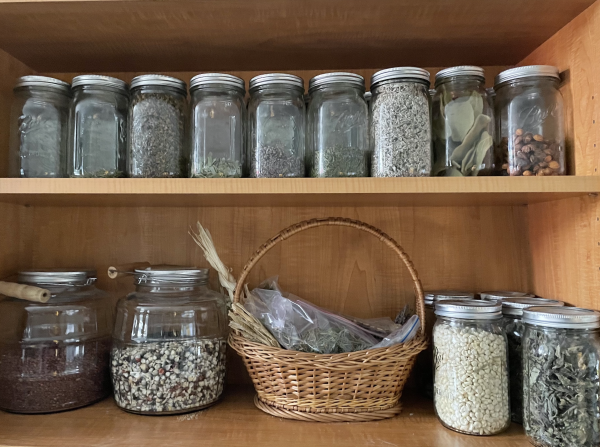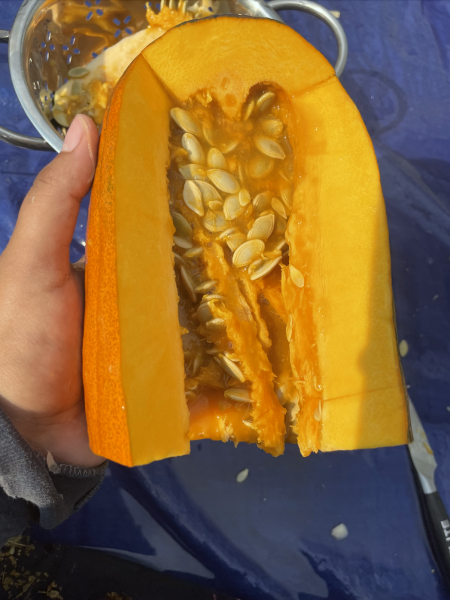 To evaluate the available food environment with a focus on the Three Sisters and other traditional foods, Dr. Winham and a trained undergraduate researcher assessed retail food stores, farmers’ markets, and food pantries on and within a 20-mile radius of each Native nation. We initially used the Nutrition Environment Measures Survey for Stores (NEMS-S) to guide the development of an ethnic-specific modification based on two of our partner Nations. Price comparisons for standard staples from the NEMS-S and traditional foods were compared across locations.
To evaluate the available food environment with a focus on the Three Sisters and other traditional foods, Dr. Winham and a trained undergraduate researcher assessed retail food stores, farmers’ markets, and food pantries on and within a 20-mile radius of each Native nation. We initially used the Nutrition Environment Measures Survey for Stores (NEMS-S) to guide the development of an ethnic-specific modification based on two of our partner Nations. Price comparisons for standard staples from the NEMS-S and traditional foods were compared across locations.
We had previously developed a Latino ethnic store instrument for the Midwest and applied our experiences from that. Our analysis included relevant access details such as distance to stores from representative community clusters, food costs, and food quality, e.g., the freshness of produce. As we built rapport with community members, we directly explored qualitative views of food insecurity and access.
In our first two years, our assessments were “noninvasive” and focused on the built environment. We utilized publicly available statistics on food insecurity, food deserts, and epidemiological statistics for tribal member health. Our food environment findings on accessibility, availability, and affordability of healthy foods were reported to the community as the research evolved to invite input on our research plan. The nutrition environment measures generated descriptive statistics on the frequencies of food accessibility, availability, and affordability within reservation food outlets and those in a 20-mile radius of reservation boundaries. The original NEMS-S rating was compared with that of the Native American NEMS-S using paired t-tests to measure the difference in scores for each store. These findings quantified the presence or absence of food deserts, traditional foods, and pricing differentials for healthy foods by market source.
 We found that the mean NEMS-S store assessment for the 10 stores was 27.5 (± 4.3), with a range of 22-34 out of a possible 54 points. All stores had the availability of 6 of the 11 measures (lower fat milk, fresh fruits, fresh vegetables, diet soda and 100% juice, whole grain bread, and healthier cereals). Few stores had the 3 measures of lean ground meat, lower fat hot dogs, or lower fat frozen dinners. Most stores had baked chips and lower-fat baked goods available. The NEMS-S scores, food availability, and price comparisons were not significantly different between the 8 regular markets and the 2 Walmart stores.
We found that the mean NEMS-S store assessment for the 10 stores was 27.5 (± 4.3), with a range of 22-34 out of a possible 54 points. All stores had the availability of 6 of the 11 measures (lower fat milk, fresh fruits, fresh vegetables, diet soda and 100% juice, whole grain bread, and healthier cereals). Few stores had the 3 measures of lean ground meat, lower fat hot dogs, or lower fat frozen dinners. Most stores had baked chips and lower-fat baked goods available. The NEMS-S scores, food availability, and price comparisons were not significantly different between the 8 regular markets and the 2 Walmart stores.
The presence of the Three Sisters crops (beans, corn, squash), wild rice, cornmeal, and maple syrup was noted. These historical or traditional foods were mentioned as culturally important by the Advisory Board members and in the ethnographic interviews. With the exception of one store, at least one variety of dry beans was available. All stores carried an assortment of plain canned beans and baked beans. Fresh ears of corn were available, although heirloom types were not present. Only four stores stocked fresh squash (butternut and acorn). Eight stores stocked corn meal, six carried wild rice, but only four had real maple syrup available.
Despite the proximity of the retail markets surveyed, few historic or traditional foods were available. The updated Food Distribution Program on Indian Reservations (FDPIR) food packages contain more culturally appropriate foods such as bison, wild rice, walleye, and corn meal. It is possible that Native clientele are not looking for indigenous foods at the markets included in this study. Food preferences and shopping patterns of the Native populations in the store service areas are unknown.
The information gathered from the store assessments can inform those in the Native American communities of food options available to improve their nutrition. In addition, due to the limited radius of stores that were assessed, this information can be presented to and used by the communities to shop more locally, thus potentially influencing the local economy. Many of the store staff interviewed indicated that they do not carry much local food, if any, and even fewer carry any product produced by the Native American communities. However, many indicated they would like to carry more locally produced items, including those produced by the Native American communities. An increase in locally or Native American-produced items in stores would potentially improve the rural communities’ economy.
